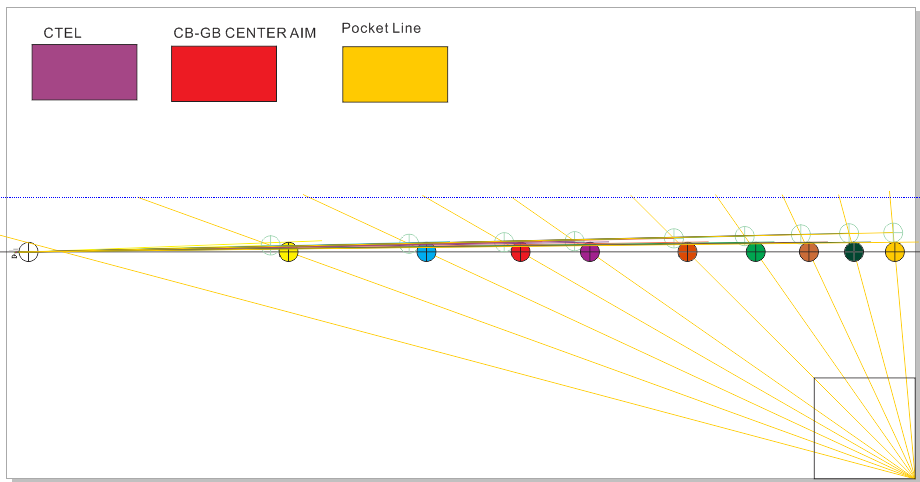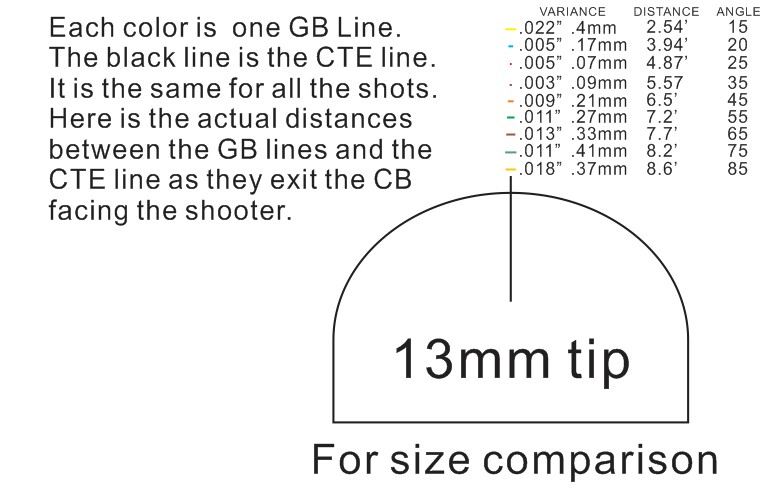We don't have to see anything - your video demonstrates it all (thanks to your careful setup).
The CB is always on the "half ball shot line" for each OB, so either...
1. Your bridge is also always on the "half ball shot line", so shooting center ball, no matter where you pivot from, would have to produce a half ball hit on every OB (and miss all but maybe one of them). Obvious geometry.
Even though the bridge v is on the half-ball hit line the PERCEPTION is not a direct half ball hit. This isn't a 2d geometry exercise.
Or...
2. You tweak your bridge position each time so each center ball shot is aimed off the "half ball shot line" at the correct angle to pocket each non-half ball shot.
Care to explain your way that's neither of those?
See the video and diagram below of the convergence lines. I think that the use of the CTE line puts the player into a space where the shooter is able to be so close to the actual shot line that the steps taken are as close to objective as can be. IF the subconscious is "adjusting" to the actual (but consciously) unknown shot line then it is doing it in a fraction of a second by virtue of starting only a tiny amount off of the actual shot line. For the shooter this whole process feels very deliberate with no conscious guessing involved.
pj <- did I mention lol?
chgo
Your lol is implied as you have never indicated any serious intent to converse in good faith on this topic. That's why I have no expectation that you are here to learn and explore. I write for the other readers and simply use you as a step to explain my thoughts on the subject.
That said this is the best example of what I have discovered that could explain the visual aspect of how the OBJECTIVE use of the CTE line and the half-ball pivot allows for the cue to end up at the shot line consistently.
188,270 views Feb 7, 2012
In this video I have marked out the Center to Edge lines and the Ghost Ball lines to show that the "pivot" which is so confusing is really just a SLIGHT body movement as the shooter moves to center ball. As the lines come back from the object ball they converge in the center of the cue ball and as they pass out the back of the cue ball they are just a millimeter at most and on top of each other at the least. Which basically means that looking at the shot from the back of the cue ball the SHOT line is never more than 1mm away from the Center to Edge line. Thus a TINY shift is all it takes to get to the shot line. (Edit: when I say tiny shift I mean that it is a super tiny distance at the back of the ball not that one is consciously or subconsciously shifting to that center cueball shot line.)
By following the CTE directions you will land on the shot line every time from almost any angle once you learn to accurately see the CTE line and orient yourself based off of it to come into the shot.
I put up all these lines to prove that following the exact same steps results in landing on the ghost ball line no matter the angle. If you choose you can mark your table in the same way and see it for yourself. THEN go to the other half of the table and do the shots without the lines marked and watch what happens.


